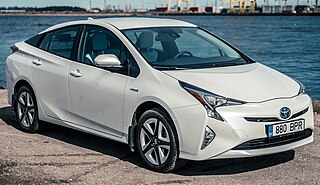
A hybrid vehicle is one that uses two or more distinct types of power, such as submarines that use diesel when surfaced and batteries when submerged. Other means to store energy include pressurized fluid in hydraulic hybrids.

The Toyota Prius is a mid-size car built by Toyota which has a hybrid drivetrain, combining an internal combustion engine with an electric motor. Initially offered as a four-door sedan, it has been produced only as a five-door liftback since 2003.

The Honda Insight is a hybrid electric vehicle that is manufactured and marketed by Honda. Its first generation was a two-door, two passenger liftback (1999–2006) and in its second generation was a four-door, five passenger liftback (2009–2014). In its third generation, it became a four-door sedan (2018–2022). It was Honda's first model with Integrated Motor Assist system and the most fuel efficient gasoline-powered car available in the U.S. without plug-in capability — for the length of its production run.

The Ford Fusion Hybrid is a gasoline-electric hybrid powered version of the mid-sized Ford Fusion sedan manufactured and marketed by Ford, now in its second generation. A plug-in hybrid version, the Ford Fusion Energi, was released in the U.S. in February 2013.
Hybrid Synergy Drive (HSD), also known as Toyota Hybrid System II, is the brand name of Toyota Motor Corporation for the hybrid car drive train technology used in vehicles with the Toyota and Lexus marques. First introduced on the Prius, the technology is an option on several other Toyota and Lexus vehicles and has been adapted for the electric drive system of the hydrogen-powered Mirai, and for a plug-in hybrid version of the Prius. Previously, Toyota also licensed its HSD technology to Nissan for use in its Nissan Altima Hybrid. Its parts supplier Aisin Seiki Co. offers similar hybrid transmissions to other car companies.

A plug-in hybrid electric vehicle (PHEV) is a hybrid electric vehicle whose battery pack can be recharged by plugging a charging cable into an external electric power source, in addition to internally by its on-board internal combustion engine-powered generator. Most PHEVs are passenger cars, but there are also PHEV versions of commercial vehicles and vans, utility trucks, buses, trains, motorcycles, mopeds, and even military vehicles.
Blended mode is a charge-depleting mode of operation for plug-in hybrid electric vehicles (PHEVs) in which most of the motive energy is supplied by the battery pack but supplemented by the internal combustion engine (ICE). In contrast, all-electric or battery electric vehicles use only the electricity provided by the battery pack as their sole source of energy in a charge-depleting manner. Both types of advanced technology vehicles use regenerative brakes to recapture kinetic energy that should not be considered a fuel source but rather an efficiency aspect of these types of electric vehicle powertrains not found in traditional internal combustion engine vehicles.
Hybrid vehicle drivetrains transmit power to the driving wheels for hybrid vehicles. A hybrid vehicle has multiple forms of motive power.

A hybrid electric vehicle (HEV) is a type of hybrid vehicle that combines a conventional internal combustion engine (ICE) system with an electric propulsion system. The presence of the electric powertrain is intended to achieve either better fuel economy than a conventional vehicle or better performance. There is a variety of HEV types and the degree to which each function as an electric vehicle (EV) also varies. The most common form of HEV is the hybrid electric car, although hybrid electric trucks, buses, boats and aircraft also exist.
The U.S. Energy Policy Act of 2005 established a federal income tax credit of up to $3,400 for the purchase of new hybrid vehicles, purchased or placed into service after December 31, 2005. Vehicles purchased after December 31, 2010 are not eligible for this credit. The law limited the tax credits to the first 60,000 eligible vehicles per carmaker, meaning that credits for popular models will be phase out before the tax break's scheduled expiration date. Note these are credits — dollar for dollar tax savings — not merely deductions. The tax credit is to be phased out two calendar quarters after the manufacturer reaches 60,000 new cars sold in the following manner: it will be reduced to 50% if delivered in either the third or fourth quarter after the threshold is reached, to 25% in the fifth and sixth quarters, and 0% thereafter. The Internal Revenue Service is responsible for certifying that certain passenger autos and light trucks qualify for the credit and the amount of the credit.

Miles per gallon gasoline equivalent is a measure of the average distance traveled per unit of energy consumed. MPGe is used by the United States Environmental Protection Agency (EPA) to compare energy consumption of alternative fuel vehicles, plug-in electric vehicles and other advanced technology vehicles with the energy consumption of conventional internal combustion vehicles rated in miles per U.S. gallon.

The Toyota Camry (XV40) is a mid-size car produced by Toyota from January 2006 to October 2011. Replacing the XV30 series, the XV40 represented the sixth generation of the Toyota Camry in all markets outside Japan, which followed a different generational lineage. Between 2006 and 2010, a badged engineered model called Daihatsu Altis sold alongside the Camry in Japan. Toyota replaced the XV40 series in 2011 with the XV50.

Hybrid taxi or hybrid electric taxi is a taxicab service provided with a hybrid electric car (HEV), which combines a conventional internal combustion engine propulsion system with an electric propulsion system.

The Toyota Prius Plug-in Hybrid is a plug-in hybrid liftback manufactured by Toyota. The first-generation model was produced from 2012 to 2016. The second-generation model has been produced since 2016. Production of the third-generation model is expected to commence in 2023.

The fleet of hybrid electric vehicles in the United States, with 5.8 million units sold through December 2020, is the second largest in the world after Japan. American sales of hybrid electric vehicles represented about 36% of the global stock of hybrids sold worldwide through April 2016.

The Toyota Prius is a full series-parallel hybrid electric compact car developed and manufactured by the Toyota Motor Corporation. The second generation Prius had been completely redesigned as a compact Kammback. The XW20 series represented the second generation of the Toyota Prius, replacing its XW10 predecessor. The United States Environmental Protection Agency (EPA) and California Air Resources Board (CARB) rated the Prius as among the cleanest vehicles sold in the United States based on smog forming and toxic emissions in 2008. Toyota sold about 1,192,000 units of the second generation Prius worldwide.

The Toyota Prius (XW10) is a subcompact hybrid car that was produced by Toyota between 1997 and 2003 in Japan. The XW10 is divided into the NHW10 and its NHW11 counterpart, both of which represent the first generation of Prius series. The Toyota Prius is the first mass-produced hybrid car, and was released 2 years ahead of other manufacturers. While the NHW10 was available exclusively to Japan, it was subsequently introduced to worldwide markets in September 2000 with the NHW11. Toyota sold about 123,000 first generation Prius. Toyota's XW10 series Prius is notable as the first vehicle based on the Toyota MC platform.

The Toyota Priusv, also named Prius α in Japan, and Prius+ in Europe and Singapore, is a hybrid gasoline-electric automobile produced by Toyota introduced in Japan in May 2011, in the U.S. in October 2011, and released in Europe in June 2012. The Prius v was unveiled at the January 2011 North American International Auto Show alongside the Prius c Concept, and it is the first Prius variant to be spun off from the Prius platform. According to Toyota the "v" stands for "versatility". It is a compact MPV with a standard full hybrid drivetrain.
The following table compares EPA's estimated out-of-pocket fuel costs and fuel economy ratings of serial production plug-in hybrid electric vehicles rated by EPA as of January 2017 expressed in miles per gallon gasoline equivalent (mpg-e), versus the most fuel efficient gasoline-electric hybrid car, the 2016 Toyota Prius Eco, rated 56 mpg‑US, and EPA's average new 2016 vehicle, which has a fuel economy of 25 mpg‑US. The table also shows the fuel efficiency for plug-in hybrids in all-electric mode expressed as KWh/100 mile, the metric used by EPA to rate electric cars before November 2010.

The Hyundai Ioniq is a compact five-door liftback manufactured and marketed by Hyundai. The nameplate Ioniq is a portmanteau of ion and unique. It is marketed as the first automobile to be offered without a standard internal combustion engine, but rather sold in hybrid, plug-in hybrid, and all-electric variants.




















